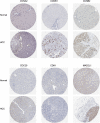Identification and Analysis of Potential Key Genes Associated With Hepatocellular Carcinoma Based on Integrated Bioinformatics Methods
- PMID: 33767726
- PMCID: PMC7985067
- DOI: 10.3389/fgene.2021.571231
Identification and Analysis of Potential Key Genes Associated With Hepatocellular Carcinoma Based on Integrated Bioinformatics Methods
Abstract
Background: Hepatocellular carcinoma (HCC) is a type of primary liver tumor with poor prognosis and high mortality, and its molecular mechanism remains incompletely understood. This study aimed to use bioinformatics technology to identify differentially expressed genes (DEGs) in HCC pathogenesis, hoping to identify novel biomarkers or potential therapeutic targets for HCC research.
Methods: The bioinformatics analysis of our research mostly involved the following two datasets: Gene Expression Omnibus (GEO) and The Cancer Genome Atlas (TCGA). First, we screened DEGs based on the R packages (limma and edgeR). Using the DAVID database, the Gene Ontology (GO) and Kyoto Encyclopedia of Genes and Genomes (KEGG) enrichment analyses of DEGs were carried out. Next, the protein-protein interaction (PPI) network of the DEGs was built in the STRING database. Then, hub genes were screened through the cytoHubba plug-in, followed by verification using the GEPIA and Oncomine databases. We demonstrated differences in levels of the protein in hub genes using the Human Protein Atlas (HPA) database. Finally, the hub genes prognostic values were analyzed by the GEPIA database. Additionally, using the Comparative Toxicogenomics Database (CTD), we constructed the drug-gene interaction network.
Results: We ended up with 763 DEGs, including 247 upregulated and 516 downregulated DEGs, that were mainly enriched in the epoxygenase P450 pathway, oxidation-reduction process, and metabolism-related pathways. Through the constructed PPI network, it can be concluded that the P53 signaling pathway and the cell cycle are the most obvious in module analysis. From the PPI, we filtered out eight hub genes, and these genes were significantly upregulated in HCC samples, findings consistent with the expression validation results. Additionally, survival analysis showed that high level gene expression of CDC20, CDK1, MAD2L1, BUB1, BUB1B, CCNB1, and CCNA2 were connected with the poor overall survival of HCC patients. Toxicogenomics analysis showed that only topotecan, oxaliplatin, and azathioprine could reduce the gene expression levels of all seven hub genes.
Conclusion: The present study screened out the key genes and pathways that were related to HCC pathogenesis, which could provide new insight for the future molecularly targeted therapy and prognosis evaluation of HCC.
Keywords: GEO; TCGA; bioinformatics; biomarker; differentially expressed genes; hepatocellular carcinoma; survival.
Copyright © 2021 Li, Lin, Cheng, Zhang and Cai.
Conflict of interest statement
The authors declare that the research was conducted in the absence of any commercial or financial relationships that could be construed as a potential conflict of interest.
Figures








Similar articles
-
Screening Hub Genes as Prognostic Biomarkers of Hepatocellular Carcinoma by Bioinformatics Analysis.Cell Transplant. 2019 Dec;28(1_suppl):76S-86S. doi: 10.1177/0963689719893950. Epub 2019 Dec 11. Cell Transplant. 2019. PMID: 31822116 Free PMC article.
-
Bioinformatics Analysis of Candidate Genes and Pathways Related to Hepatocellular Carcinoma in China: A Study Based on Public Databases.Pathol Oncol Res. 2021 Mar 26;27:588532. doi: 10.3389/pore.2021.588532. eCollection 2021. Pathol Oncol Res. 2021. PMID: 34257537 Free PMC article.
-
CDK1, CCNB1, CDC20, BUB1, MAD2L1, MCM3, BUB1B, MCM2, and RFC4 May Be Potential Therapeutic Targets for Hepatocellular Carcinoma Using Integrated Bioinformatic Analysis.Biomed Res Int. 2019 Oct 13;2019:1245072. doi: 10.1155/2019/1245072. eCollection 2019. Biomed Res Int. 2019. PMID: 31737652 Free PMC article.
-
Identification of most representative hub-genes for diagnosis, prognosis, and therapies of hepatocellular carcinoma.Chin Clin Oncol. 2024 Jun;13(3):32. doi: 10.21037/cco-23-151. Chin Clin Oncol. 2024. PMID: 38984486
-
Identification of potential genes associated with metastasis in osteosarcoma: an integrated bioinformatics analysis.Musculoskelet Surg. 2025 Feb 25. doi: 10.1007/s12306-025-00891-z. Online ahead of print. Musculoskelet Surg. 2025. PMID: 40000579 Review.
Cited by
-
Identification of Differentially Expressed Genes Associated with the Prognosis and Diagnosis of Hepatocellular Carcinoma by Integrated Bioinformatics Analysis.Biomed Res Int. 2022 Oct 22;2022:4237633. doi: 10.1155/2022/4237633. eCollection 2022. Biomed Res Int. 2022. PMID: 36317111 Free PMC article.
-
Eleven metabolism‑related genes composed of Stard5 predict prognosis and contribute to EMT phenotype in HCC.Cancer Cell Int. 2023 Nov 17;23(1):277. doi: 10.1186/s12935-023-03097-0. Cancer Cell Int. 2023. PMID: 37978523 Free PMC article.
-
Expression of the checkpoint kinase BUB1 is a predictor of response to cancer therapies.Sci Rep. 2024 Feb 23;14(1):4461. doi: 10.1038/s41598-024-55080-y. Sci Rep. 2024. PMID: 38396175 Free PMC article.
-
Micronome Revealed miR-205-5p as Key Regulator of VEGFA During Cancer Related Angiogenesis in Hepatocellular Carcinoma.Mol Biotechnol. 2023 Jul;65(7):1178-1186. doi: 10.1007/s12033-022-00619-5. Epub 2022 Dec 3. Mol Biotechnol. 2023. PMID: 36460813
-
Integrated bioinformatics analysis of IFITM1 as a prognostic biomarker and investigation of its immunological role in prostate adenocarcinoma.Front Oncol. 2022 Dec 14;12:1037535. doi: 10.3389/fonc.2022.1037535. eCollection 2022. Front Oncol. 2022. PMID: 36591519 Free PMC article.
References
-
- Aufhauser D. D., Jr., Sadot E., Murken D. R., Eddinger K., Hoteit M., Abt P. L., et al. (2018). Incidence of occult intrahepatic metastasis in hepatocellular carcinoma treated with transplantation corresponds to early recurrence rates after partial hepatectomy. Ann. Surg. 267 922–928. 10.1097/sla.0000000000002135 - DOI - PMC - PubMed
LinkOut - more resources
Full Text Sources
Other Literature Sources
Research Materials
Miscellaneous

